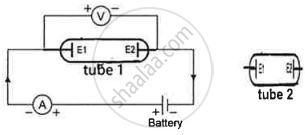Advertisements
Advertisements
Question
A wire of resistance 9 ohm having length 30 cm is tripled on itself. What is its new resistance?
Solution
Resistance (R) = 9 ohm
Length l = 30 cm
New Length (l) = 30 cm = `l/3` = 10 cm
New area an = 3a
`R = ρ 1/a`
Initial resistance `9 = ρ 30/a` ...(i)
New resistance `R_n = ρ 10/(3a)` ...(ii)
On dividing eqn (ii) by (i), we get,
`R_n/9 = (ρ 10/(3a))/(ρ 30/a)`
`R_n /9 = 10/90`
`R_n /9 = 1/9`
`R_n /1 = 9/9`
Rn = 1 Ω
Hence, The new resistance = 1 ohm.
APPEARS IN
RELATED QUESTIONS
Write the formula of resistivity
Fill in the following blank with suitable words:
Resistance is measured in .............. The resistance of a wire increases as the length ..............; as the temperature ..............; and as the cross-sectional area .............. .
How much energy is consumed when a current of 5 amperes flows through the filament (or element) of a heater having resistance of 100 ohms for two hours? Express it in joules.
Draw a neat diagram for the verification of Ohm’s law by voltmeter-ammeter method. By another diagram show the relation between p.d. and current.
Define Current density.
State microscopic form of Ohm’s law.
A heater of 220 V heats a volume of water m 5 mint time. A heater of 110 V heat in ten second. The resistance of the conductor is

Vinita and Ahmed demonstrated a circuit that operates the two headlights and the two sidelights of a car, in their school exhibition. Based on their demonstrated circuit, answer the following questions.
- State what happens when switch A is connected to:
a) Position 2
b) Position 3 - Find the potential difference across each lamp when lit.
- Calculate the current.
a) in each 12 Ω lamp when lit.
b) In each 4 Ω lamp when lit.
OR - Show, with calculations, which type of lamp, 4.0 Ω or 12 Ω, has the higher power.
The circuit depicted in the figure is employed for studying Ohm's Law. Instead of using a standard resistor, a student opts for a glass tube filled with mercury (tube 1), connected to the circuit through two electrodes E1 & E2. He records the readings of the ammeter and voltmeter, thereby calculating the resistance. The student repeats the experiment by substituting tube 1 with tube 2, where the same amount of mercury fills the tube 2.

Neglecting internal resistance of the cell use (> or < or =) to compare
- the resistance in both the cases.
- the voltmeter readings in both the cases.
- the specific resistance in both the cases.
